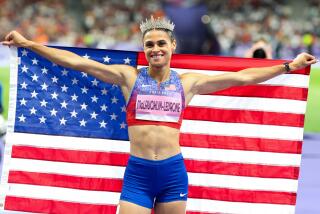Series Have Serious Flaws
- Share via
The Indy Racing League, the outfit that puts on the Indianapolis 500, made its West Coast debut with a crackling good race Sunday at California Speedway in Fontana.
Sam Hornish Jr., the defending series champion, caught Jaques Lazier coming off the fourth turn on the last lap--their cars even brushed tires--and won the Yamaha 400.
Dozens of people were thrilled.
“The Yamaha 400?” went the prerace irreverence? “Does that mean there’s a Yamaha for each of the fans?”
That, of course, was nowhere near accurate. There probably were, oh, 15,000 or so people on hand for the race, not counting, drivers, pit crews, track workers and media folks. At a facility where, next month, a NASCAR Winston Cup stock car race will attract a sellout crowd of more than 92,000.
Speaking of sellout crowds, one of 180,000 took in the Winston Cup race Sunday at the half-mile bullring in Bristol, Tenn.
CART, the outfit that doesn’t put on the Indy 500, even though its drivers pilot similar open-wheel cars, has been racing at California Speedway since 1997 and, although it has never experienced the kind of non-crowd the IRL drew Sunday, it also has never come close to selling out.
CART’s showcase California race--indeed, it’s the jewel of the entire series--is the Toyota Grand Prix of Long Beach, which will be back again in mid-April. Because it’s a street race, with people coming and going, there probably never has been an accurate crowd estimate. It was a given, though, that the figures went up every year.
Last spring, the estimates were down. And there were visible gaps in the bleachers where there never were gaps before.
So, what does all this tell us?
In a day and age when auto racing, stock car style, has never been hotter--NASCAR’s popularity rivals the NFL’s--open-wheel racing, which many consider a far purer version of the speed sport, is becoming a harder sell, practically by the minute.
Can you imagine another major sporting event in Southern California drawing only 16% of capacity? You’d think more than 15,000 would show up by accident for a big-time race.
Didn’t used to be this way. In a simpler day, when there was only one group sanctioning and promoting Indy car racing, it was a thriving fruit on the sporting tree.
Then Tony George, president of the Indianapolis Motor Speedway, took issue with the way CART was running things and started his own group, the IRL. That was in the mid-’90s, and there hasn’t been a minute’s peace ever since.
George said the IRL would be run on American ovals, would provide an avenue to Indy for young American drivers--foreign drivers constituted a third of the field Sunday--and would be cost conscious. He also, in effect, legislated CART drivers out of the Indy 500.
CART said it would continue to run street and road courses, as well as ovals, in this country and others, that it made no difference where its drivers came from, and who needed the Indy 500 anyway.
Now, it seems, everybody miscalculated.
With the exception of the Indianapolis 500, the IRL remains, for the most part, a struggling series--as witness Sunday’s race here. True, the race was a late addition to California Speedway’s schedule and the IRL has no history here. Still, it has been around for half a dozen years and any semi-knowledgeable racing fan is aware of it.
And CART, for all of its bluster, has become a series in search of a focus. It’s best-selling races are the ones it puts on overseas, to the dismay of its sponsors, who want to sell their products to the U.S. public, and think the Indy 500 is a great place to do that.
So now, it also seems, everybody needs everybody else.
After several years, George rescinded the rule that kept CART teams out of the 500 and they, at great expense, considering the vast difference in engines, have been filtering back the last several years. CART, in rules revisions for next season, will have cars very similar to the IRL’s, so that there can be driver interchange. The gap, apparently, is narrowing.
Even so, they are very distinct operations.
Last fall, Roger Penske, one of CART’s founding fathers, announced that his team, at the urging of sponsoring Marlboro, would be moving to the IRL. His team won’t be the last.
But CART certainly isn’t going to quit, so the beat goes on.
“We have a tremendous product [in open-wheel racing] but we haven’t been able to communicate that properly,” Penske said before Sunday’s race. “There’s been so much strife [in recent years], we’ve never been able to talk about it. We haven’t been able to get people to focus [on the racing].
“Right now, there are two open-wheel series and it’s a simple fact of life that we need one.... We’ve got to have a consistent series and we’ve got to have just one.”
Yup, and soon. Trouble is, no one has figured out how to do that. Somebody had better. Before everybody who used to care goes on to something else.
Or has that already happened?
More to Read
Go beyond the scoreboard
Get the latest on L.A.'s teams in the daily Sports Report newsletter.
You may occasionally receive promotional content from the Los Angeles Times.










